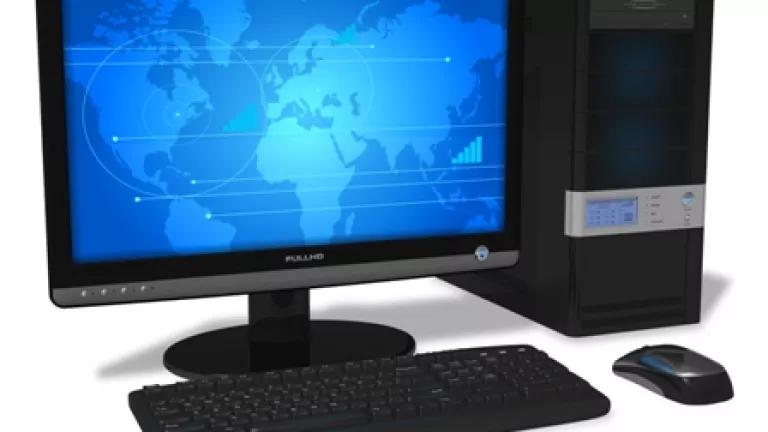California Computer Efficiency Standards: Nice Job on the First Draft, Let's Make Them Even Better!

The California Energy Commission's (CEC) proposed energy efficiency standards for computers, monitors and electronic signage - which could become a blueprint for the nation - are a good step, but they can go further to maximize the energy- and money-saving potential for consumers.
That's the message NRDC sent to the CEC last week in formal comments submitted in response to the commission's Appliance Efficiency Pre-Rulemaking Staff Report on Computers, Computer Monitors and Signage Displays published in March.
The standards would be the first in the nation for these products and could pave the way for the U.S. Department of Energy (DOE) to implement equivalent standards nationwide. If the proposed California standards were adopted nationwide, they could save U.S. consumers $2.6 billion on their electricity bills as well as 21 billion kilowatt hours of electricity - the equivalent output of seven coal-fired power plants (500 megawatts), or 15 million tons of carbon pollution, every year.
Why standards are needed
California's computers - including desktops, and laptops - and displays (computer monitors and signage displays) guzzle roughly 8.3 billion kilowatt of electricity hours annually, or $1.3 billion in annual electricity bills, according to the CEC. That's enough to power nearly all the residences in Los Angeles for an entire year. The standards for notebook computers, small scale servers, and workstation computers (where computer and monitor are integrated) would take effect in 2017. Standards for desktops and electronic signage would follow in 2018.
A recent study by the University of California (UCI) Plug Load Research Center found that while office desktop computers are switched on for 77 percent of the time, they're idle - as in doing no work - for 61 percent of it while still using electricity. Although everyone should remember to power down their computers and screens when done, and buy ENERGY STAR® computers whenever possible, realistically not everyone will. Also, we don't know when we buy a computer whether it was designed to use energy as efficiently as possible. Standards ensure a minimum efficiency level.
Our Recommendations
We urge the CEC to improve its draft standards to maximize energy and utility bill savings and to future-proof them against projected technological advances by:
- Decreasing the limits for both desktop and notebook computers. CEC's proposed energy use limit for desktops is appropriate for today's models, but will be too high by the time the standards become effective in 2018, due to natural efficiency gains in computer technology. The proposed limit for notebooks is already too high for today's models, since many notebooks on the market today are already far below the allowance (by as much as 78 percent in one case). The limit needs to be significantly reduced to serve its intended purpose when the standards go into effect in 2017.
- Reducing the display allowance to bring it in line with current technology. The display allowance accounts for the energy used by the monitor on notebooks and all-in-one computers. It is separate from the base allowance for the computer because it varies depending on screen size and resolution. CEC's proposal was aligned with ENERGY STAR® version 6, which was developed based on 2010-2012 technology, and is outdated for standards meant to be effective in 2017 and beyond.
- Adjusting other various allowances, such as for memory, additional disks, and discrete graphics cards to better align with power use of current technology.
- Introducing a minimum efficiency standard for computer power supplies. Some internal power supplies used by desktop computers are extremely inefficient; wasting nearly half of all the energy used by the computer before it even reaches the computer itself. Efficient power supplies are broadly available on the market and save consumers two to three times as much in energy costs over the life of the computer as the $5 to $15 it costs to upgrade to an efficient model.
As for electronic signage - screens increasingly appearing in stores, restaurants, museums, hotels and airports - the CEC's proposals are inadequate. Such screens are typically larger, brighter, on for longer than computer monitors, and consume nine times as much energy on average; but the CEC proposes to apply TV efficiency standards from 2009. We urge the CEC to adopt the California Investor-Owned Utilities proposals, which would provide a very effective 2-to-1 benefit to cost ratio and save Californians 260 million kilowatt-hours of electricity annually, enough electricity to power 40,000 homes each year. We also strongly recommend that the CEC expand its standards to cover the currently unregulated displays larger than 1400 square inches (roughly 60 inches diagonal size). We estimate these larger screens account for 30 percent of the energy consumption of electric signage, making it critical to include them in the standards.
Good work, CEC!
If the CEC proposals, with our recommendations, are implemented, they have the potential to reduce computer and display energy consumption by one-third, saving 2.7 billion kilowatt-hours of electricity annually, equivalent to the consumption of all the households in the city of San Jose. This would also put $430 million back into Californians' pocketbooks from avoided electricity bills and reduce carbon pollution by 1 million tons annually.
But the reach is potentially far wider. Where California leads, other states and even the federal government often follow. This, together with the fact that manufacturers are unlikely to make separate machines exclusively for the Californian market, means efficiency standards set in California could be a blueprint for devices sold across America - and potentially the globe.
We're excited to support the CEC in making these ground-breaking standards a reality - and urge the commission to implement our proposed amendments to ensure they are as effective and ambitious as possible.
You can read more about the details of our recommendations here.
